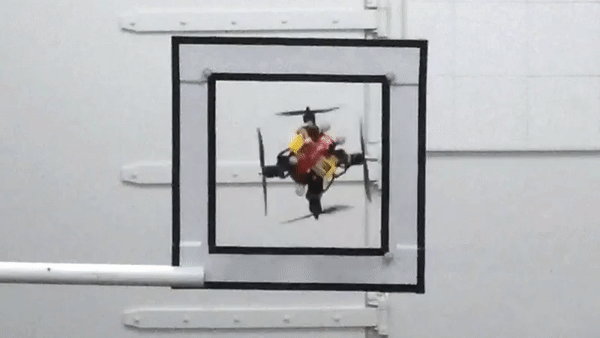This Flying Drone Can Shrink And Squeeze Through Tight Spaces Like Ant-Man
Cooky - Aug 16, 2019

This drone can retract its extended arms and squeeze through tight space without the need for extra hardware which can drain the craft's battery faster
- Hundreds Of Drones Crashed Into Building During Performance
- IIT Kharagpur Develops Drones To Bring 5G To Zero Network Area
- Researchers Make Lighter & Biodegradable Drones With Pineapple Leaves
There are various unique ways for us to use drones, such as delivering food or scorching the ground. However, one of the most popular applications is for searching and carrying out rescue missions at places dangerous for human beings to venture. Those places are occasionally cramped, which makes standard unmanned aircraft unable to fit. Nevertheless, there is a new drone design, allowing them to shrink temporarily to squeeze through small spaces.
This new drone is called “Passively Morphing Quadcopter” by researchers from HiPeRLab of UC Berkeley, or High-Performance Robotics Laboratory. This quadcopter is not the first one which can reconfigure its own shape in the air. However, this one is the only quadcopter which can do shape reconfiguration without any extra powered hardware which can reduce flight times by putting an additional drain on the battery life of the drone.

This new drone has four outstretched arms attached to its main body along with hinged joints. Each of the arms includes an electric motor as well as propellor on the drone’s end. On each arm’s underside, there is a spring that is under tension. Therefore, when the craft is off, each arm is pulled down, reducing the craft’s overall footprint. However, these springs are not terribly strong. When the drone roars to life, each propeller generates enough lift to release the tension, which causes all four arms to extend fully and fly upwards.
When the drone approaches a space which is smaller than itself with extended arms, the drone can automatically plot a course as well as a trajectory for its rotors to turn off, causing the arms to retract so that the aircraft can squeeze through.
The craft is carried to the other side by its momentum, and at the point when its rotors can spin again, its arms can fully extend, allowing the drone to stabilize and continue exploring.
Before the drone can be used in real-life situations, some problems need to be solved. This new design can be controlled by a skillful pilot who can use VR goggles to get a first-person view from the craft. However, if we ask this unmanned aircraft to do this maneuver performance all alone, it needs to pull off complicated analysis as well as a trajectory which the drone must do all by itself. This problem has not been tackled by the research team from UC Berkeley yet.
For now, when this maneuver is performed, the craft will collapse and begin to fall out of the sky because its propellers cannot provide thrust any more. If we want it to power back up, recover and stabilize itself before it continues exploring, a lot of space is required on the other side.
Featured Stories

Features - Jul 01, 2025
What Are The Fastest Passenger Vehicles Ever Created?

Features - Jun 25, 2025
Japan Hydrogen Breakthrough: Scientists Crack the Clean Energy Code with...

ICT News - Jun 25, 2025
AI Intimidation Tactics: CEOs Turn Flawed Technology Into Employee Fear Machine

Review - Jun 25, 2025
Windows 11 Problems: Is Microsoft's "Best" OS Actually Getting Worse?

Features - Jun 22, 2025
Telegram Founder Pavel Durov Plans to Split $14 Billion Fortune Among 106 Children

ICT News - Jun 22, 2025
Neuralink Telepathy Chip Enables Quadriplegic Rob Greiner to Control Games with...

Features - Jun 21, 2025
This Over $100 Bottle Has Nothing But Fresh Air Inside

Features - Jun 18, 2025
Best Mobile VPN Apps for Gaming 2025: Complete Guide

Features - Jun 18, 2025
A Math Formula Tells Us How Long Everything Will Live

Features - Jun 16, 2025
Comments
Sort by Newest | Popular